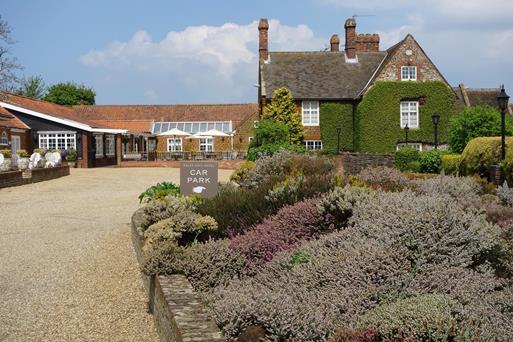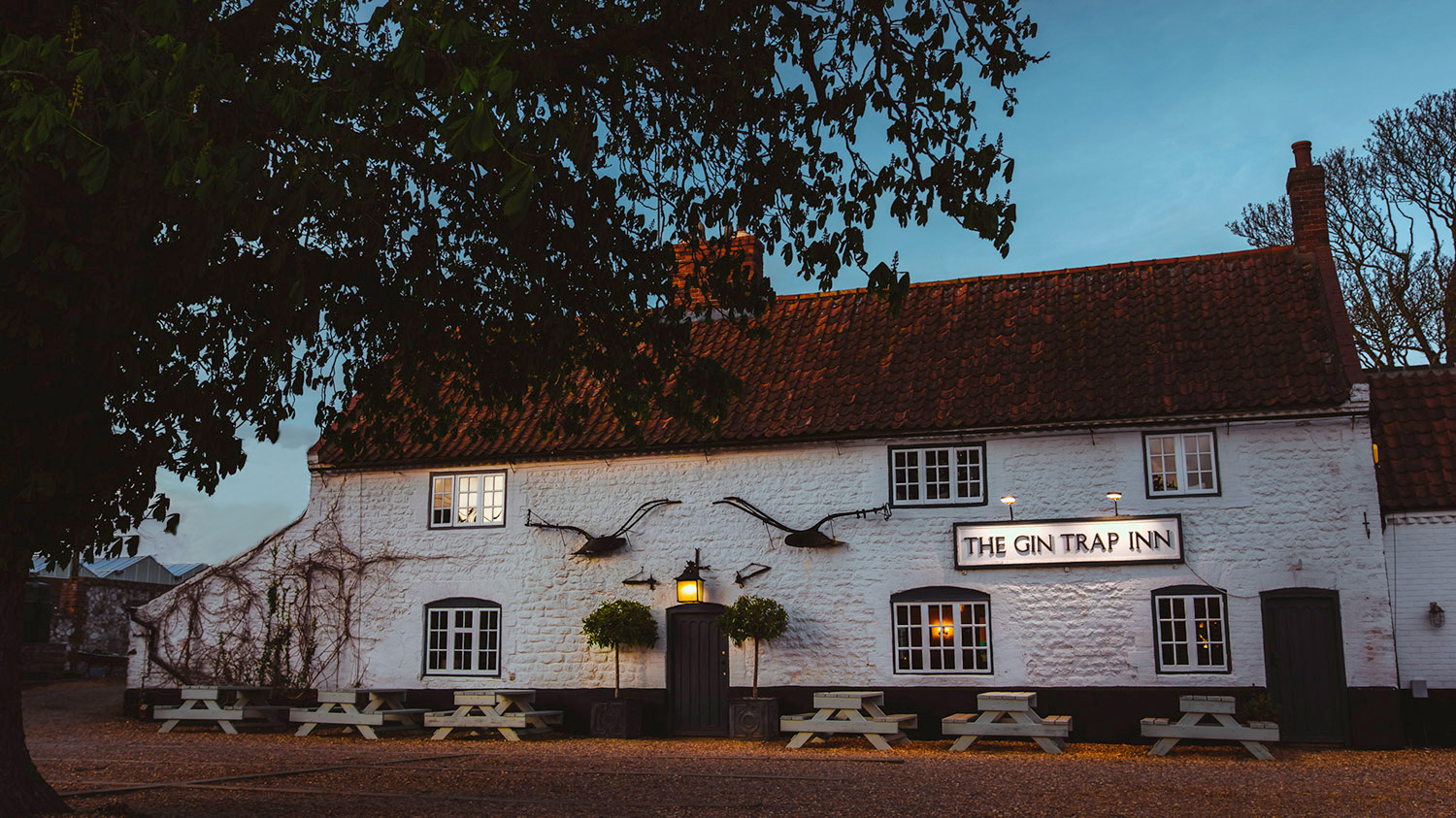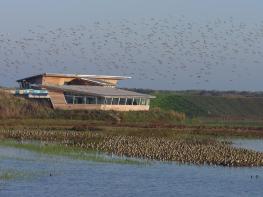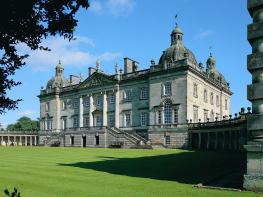Brook Bungalow is a large secluded well-appointed holiday home in a delightful north Norfolk…
Old Hunstanton's dunes

From the coast's wide-open magnificence to a peaceful nature reserve
8 miles (12.9kms)
About the walk
Old Hunstanton is steeped in history and legend. It is said that St Edmund was shipwrecked here in AD 855, and was so grateful for being spared a watery death in the Wash that he built a chapel as an act of thanksgiving. The 13th-century ruins still stand today, looking out across grey stormy seas from near the old lighthouse. Edmund left Hunstanton soon after and went on to become King of the East Angles. Between AD 869 and 870 Vikings invaded his kingdom and fought battles until he was captured. He refused to renounce his faith and died a particularly unpleasant death.
Some years later, Edmund's grave was dug up and his body was found to be uncorrupted. It was declared a miracle and his remains were moved around the country for many years in an attempt to keep them safe from Vikings. They were eventually kept in Bury St Edmunds, although records are vague about what happened to them later. Some say they were taken to France, while others claim he was reinterred at Bury after the Reformation. Regardless of the fate of the relics, Hunstanton is proud of its claim to a small piece of the saint's history.
Edmund is not the only remarkable historical figure to be associated with the village. Members of the Le Strange family have been squires and landlords here for more than 800 years. They laid claim to the beach and, according to one charter, all that is in the sea for as far as a horseman can hurl a spear at low tide. The family still hold the title of Lord High Admiral of the Wash. There is a popular local story that tells of a famous German lady swimmer called Mercedes Gleitze performing the impressive feat of swimming the Wash from Lincolnshire to Norfolk in the 1930s and the admiral promptly stepping forward to claim her as his rightful property!
The lighthouse that has become a symbol of this attractive town dates from 1840. When World War I broke out in 1914, the light was extinguished and was never lit again. The lighthouse is now in private hands. Because of its strategic position on the coast, Hunstanton was the site of some very clandestine happenings in that war. Hippisley Hut, a bungalow, was used to house a secret listening post to monitor the activities of German Zeppelins, and some of its secrets remain hidden even today. Before you leave the village, spare a thought for poor William Green, a Light Dragoon officer, who was shot here in 1784 by smugglers while helping the King's customs men. The killers were never brought to justice, although the villagers, being such a small community, must have known their identities. The association of the village with contraband can be seen in the name Smugglers' Lane, along which you will walk.
Walk directions
Walk towards the sea and turn left to head across the dunes. This is Norfolk at its best, with miles of sandy beaches and dunes, and the lighthouse at Old Hunstanton visible on a cliff. Keep close to the golf course and after about a mile (1.6km) you will arrive at a colourful row of beach huts.
When you see a gap in the fence to your left, take the path across the golf course and continue straight ahead into Smugglers' Lane. Emerging at a junction, take the lane opposite, past the post box to reach Caley Hall Hotel. Cross the A149 and aim for the road signed 'To St Mary's Church', where you can see the grave of William Green.
Turn right up Chapel Bank, through a tunnel of shade, before reaching open farmland. After 700yds (640m), turn left on a grassy track, Lovers Lane, a permissive path. When you reach Lodge Farm, follow the track around farm buildings to a lane.
Turn left along the lane. When you see the fairy-tale lodge of Hunstanton Park ahead, follow the lane round to the right along an avenue of mature trees. In the field to your right you will see the ruins of 13th-century St Andrew's Chapel.
Bear left at Downs Farm and head for the gate to enter Ringstead Downs Nature Reserve, one of just a few areas in Norfolk that is chalk rather than sand. It belongs to the Norfolk Wildlife Trust and the area is grazed by traditional hill sheep. This is one of the most beautiful parts of the walk. Follow the path right through the reserve until you reach a lane.
Turn left into Ringstead, where the tower of St Peter's Church still stands. Stay on this road as it bends right and left through the village, passing The Gin Trap Inn. The road climbs gently out of the village, forking right then left along the Peddars Way towards a sail-less windmill.
At the last house, The Crows Nest, look for the waymarked path to the left. This follows a field boundary, then turns right into a lovely tunnel of hedges.
Cross the A149 and walk through Holme village, with its long green, to reach the car park.
Additional information
Country tracks, lanes, muddy paths and sand dunes
Sandy beaches, rolling chalk valleys and farmland
On lead in nature reserves and on farmland
OS Explorer 250 Norfolk Coast West
Beach car park at Holme next the Sea (pay at kiosk)
By beach car park
WALKING IN SAFETY
Read our tips to look after yourself and the environment when following this walk.
Find out more
Also in the area
About the area
Discover Norfolk
The North Norfolk Coast is designated an Area of Outstanding Natural Beauty and probably the finest of its kind in Europe. Here you’ll find a string of quaint villages and small towns – Holkham, Wells-next-the-Sea and Cley next the Sea are 21st-century favourites, while Sheringham and Cromer are classic examples of a good old-fashioned seaside resort where grand Victorian hotels look out to sea. Further round the coast you'll find Great Yarmouth, one of the most popular resorts in the UK and packed full of amusements, shops and seashore entertainment. And let's not forget Norwich, the region's only city.
Norfolk prides itself on its wealth of historic houses, the most famous being Sandringham, where Her Majesty the Queen and her family spend Christmas. Many of Norfolk’s towns have a particular charm and a strong sense of community. The quiet market towns of Fakenham and Swaffham are prime examples, as well as Thetford, with its popular museum focusing on the TV comedy series Dad’s Army which was filmed in the area.
Nearby stays
Restaurants and Pubs
Nearby experiences
Recommended things to do
Why choose Rated Trips?
Your trusted guide to rated places across the UK
The best coverage
Discover more than 15,000 professionally rated places to stay, eat and visit from across the UK and Ireland.
Quality assured
Choose a place to stay safe in the knowledge that it has been expertly assessed by trained assessors.
Plan your next trip
Search by location or the type of place you're visiting to find your next ideal holiday experience.
Travel inspiration
Read our articles, city guides and recommended things to do for inspiration. We're here to help you explore the UK.














